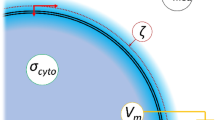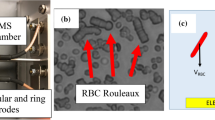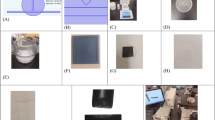Abstract
As was first shown in work on the red blood cell1, the high permittivity (of the order of thousands) of biological cell materials is the result of an electric condenser action originating in an extremely thin section—possibly a bimolecular lipid layer—of the surface envelope, in which the principal part of the cell resistance is located. Under certain conditions, the capacity of this ‘membrane’ condenser can be calculated2 from the observed permittivity and has been found to be closely the same for certain types of cell, namely, about 0.9 µF./sq. cm., in the radio-frequency region1,3–5, corresponding to a probable thickness of the membrane of about 30 A. This calculation can be carried through rigorously only when the number of cells in the material is small. The analysis of denser cell materials raises the question of the form of the relationship between permittivity (ɛ) and fractional cell volume (ρ) in a system exhibiting this type of dielectric mechanism. Although this problem has been given some theoretical attention in the past, the only experimental data now available are those obtained in my early work on dog erythrocytes1.
This is a preview of subscription content, access via your institution
Access options
Subscribe to this journal
Receive 51 print issues and online access
$199.00 per year
only $3.90 per issue
Buy this article
- Purchase on Springer Link
- Instant access to full article PDF
Prices may be subject to local taxes which are calculated during checkout
Similar content being viewed by others
References
Fricke, H., J. Gen. Physiol., 9, 137 (1925).
Fricke, H., Phys. Rev., 26, 678 (1925); J. App. Phys., 24, 644 (1953).
Fricke, H., and Curtis, H. J., Nature, 134, 102 (1934); 135, 436 (1935).
Cole, K. S., Cole, R. H., and Curtis, H. J., J. Gen. Physiol., 18, 877 (1935); 19, 609 (1936); 21, 591 (1938). Cole, K. S., and Curtis, H. J., “Medical Physics”, 2, 82 (Year Book Publishers, Inc., Chicago, 1950).
Fricke, H., and Curtis, H. J., J. Gen. Physiol., 18, 821 (1935); J. Phys. Chem., 41, 729 (1937).
Fricke, H., Symp. Quant. Biol., Cold Spring Harbor, 1, 117 (1933).
Hamburger, H. J., and Abderhalden, E., “Handbuch der biologischen Arbeitsmethoden”, Abt. IV, Teil 4, 965 (1926).
Author information
Authors and Affiliations
Rights and permissions
About this article
Cite this article
FRICKE, H. Relation of the Permittivity of Biological Cell Suspensions to Fractional Cell Volume. Nature 172, 731–732 (1953). https://doi.org/10.1038/172731a0
Issue Date:
DOI: https://doi.org/10.1038/172731a0
This article is cited by
-
A reevaluation of iron binding by Mycobactin J
JBIC Journal of Biological Inorganic Chemistry (2018)
-
Experimental and theoretical studies of the effect of electrode polarisation on capacitances of blood and potassium chloride solution
Medical & Biological Engineering & Computing (2002)
-
Radio-frequency microtools for particle and live cell manipulation
Naturwissenschaften (1994)
-
Dielectric properties of human blood and erythrocytes at radio frequencies (0.2?10 MHz); dependence on cell volume fraction and medium composition
European Biophysics Journal (1994)
-
Electrical Properties of the Plasma Membrane of Erythrocytes at Low Frequencies
Nature (1956)
Comments
By submitting a comment you agree to abide by our Terms and Community Guidelines. If you find something abusive or that does not comply with our terms or guidelines please flag it as inappropriate.



